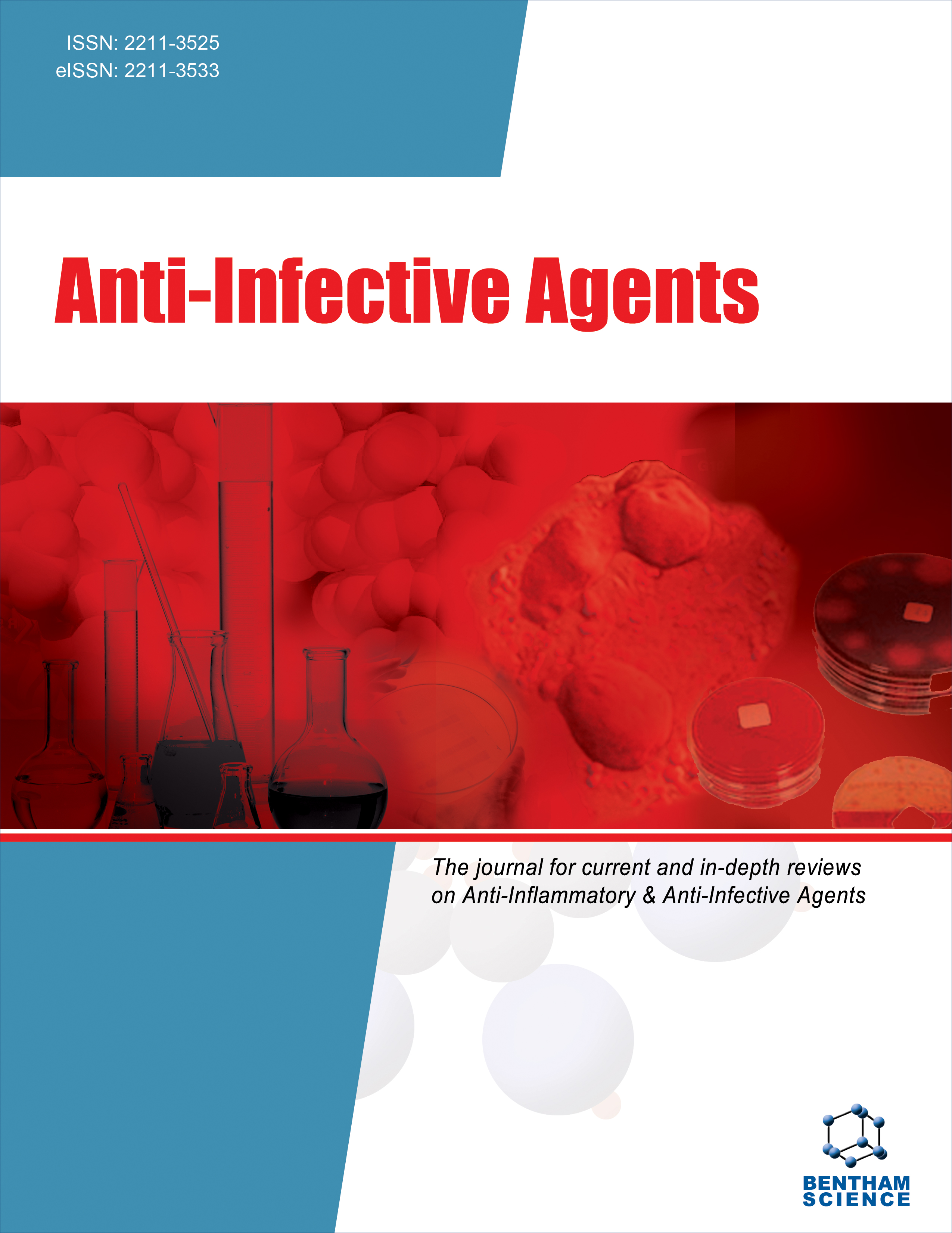- Home
- A-Z Publications
- Anti-Infective Agents
- Previous Issues
- Volume 13, Issue 1, 2015
Anti-Infective Agents - Volume 13, Issue 1, 2015
Volume 13, Issue 1, 2015
-
-
Bee Venom: Its Potential Use in Alternative Medicine
More LessBy Yuva BellikIn recent times, bee venom (BV) from honey bee (Apis mellifera L.) has become the focus of interest as a form of alternative and preventive medicine for the treatment of a number of clinical cases such as arthritis, rheumatism, pain, cancer and a vast range of other conditions. BV contains several biochemically and pharmacologically active substances. Some of these compounds are well studied and their mechanis Read More
-
-
-
Phenolics Constituents of Different Types of Propolis and their Antimicrobial Activities
More LessAuthors: Mokhtar Benhanifia and Wessam M. MohamedPropolis is identified as natural resource with effective biological and pharmacological activities. Here, we will discuss the plant sources, chemical composition, biological activities and toxicity of different types of propolis. Propolis is considered as a natural remedy against resistant microorganisms with a promising usage in the near future, but further studies should be conducted to investigate its therapeutic role.
-
-
-
The Importance of Botanical Origin for Api-products as Antibiotics
More LessAuthors: Leila Ait Abderrahim, Fatiha Abdellah and Laid BoukraaInfectious diseases represent an important cause of mortality which motivated the pharmaceutical companies to develop new antimicrobial drugs in recent constant years, especially due to the constant emergence of microorganisms resistant to conventional antimicrobials. Nature has provided many things for humankind over the years, including the tools for the first attempts at therapeutic intervention. Api-products, r Read More
-
-
-
Bee Products: The Rediscovered Antibiotics
More LessBy Laid BoukraaHoney and other bee products have been subjected to laboratory and clinical investigations over the past few decades, the most significant discovery being their antibacterial activity. The emergence of antibiotic-resistant strains of bacteria has made the current use of antibiotic therapy problematic, resulting in earlier remedies being reassessed. Honey, propolis, royal jelly and bee venom, all exhibit strong antibacterial a Read More
-
-
-
Honey: The Natural Inhibine”
More LessAuthors: Rezzan Aliyazicioglu and Laid BoukraaHoney has been shown to contain glucose oxidase, which produces gluconic acid and hydrogen peroxide from glucose. Dilution of honey results in a significant increase in the activity of this molecule. Inhibine, an antibacterial substance previously described in honey, has been identified as hydrogen peroxide, which is manufactured at inhibine assay by the natural glucose oxidase in honey. Inhibine levels have been shown to Read More
-
-
-
Antimicrobial Activity of Royal Jelly
More LessAuthors: Fahad M. Alreshoodi and Yasmina SultanbawaRoyal jelly (RJ) is a unique secretion that is produced by the mandibular and hypopharyngeal glands of worker bees and used globally for its unique health benefits. It consists mainly of water, proteins, fatty acids, minerals, carbohydrates, vitamins, and other components. RJ as a raw and purified product has been evaluated for its bioactivity in in-vitro, animal and clinical studies and one of the most notable findings was its antimicr Read More
-
-
-
Molecular Hybridization and Preclinical Evaluation of Imines From Para-substituted 4-phenyl 2-amino Thiazole Incorporated with Isatin Analogues as Antitubercular Agents
More LessAuthors: Nice Joy and Bijo MathewA series of isatin imines incorporated with 4-sustituted phenyl 2-amino thiazole was synthesized on the basis of molecular hybridization drug design principle. The structures of the derivatives were confirmed by IR, 1HNMR and Mass analyses. The titled derivatives were screened against M.tuberculosis strain H37RVusing alamar blue susceptibility test. Compound 3-{[4-(4- hydroxyphenyl)-1, 3-thiazol-2-yl] imino}-1, 3-dihydr Read More
-
-
-
Synthesis, Anti-HIV, Antimicrobial Evaluation and Structure Activity Relationship Studies of Some Novel Benzimidazole Derivatives
More LessAuthors: Geeta Yadav, Swastika Ganguly, Sankaran Murugesan and Abhimanyu DevIn this study 26 novel benzimidazole compounds bearing alkyl chain as linker at N-1 position were synthesized and evaluated to investigate their possible anti-HIV and antimicrobial activities. Structures of the synthesized compounds were elucidated by spectral data. HIV-1 RT inhibitory activity was evaluated by using HIV-1 RT RNA-dependent DNA polymerase activity assay. Among these derivatives, compounds 43, 45, 50 and 5 Read More
-
-
-
Tailoring Effect of Alkyl Chain Length and Counter Anion on Antimicrobial Behavior of 4–Vinyl Pyridine–based Cationic Polymers
More LessAuthors: Yashwant Shandil, Ghanshyam S. Chauhan, Jou–Hyeon and Rajeev K. SharmaPolymers exhibiting anti–microbial properties constitute an important class of bioactive polymers whose properties can be easily tuned by simple polymer analogous reactions. Two series of new polymers were synthesized from 4–Vinyl pyridine, which was polymerized and quaternized in situ by using alkyl bromides of varying alkyl chain length. The well–characterized polymers were evaluated for their anti–microbial activity ag Read More
-
-
-
Antibacterial Properties of Tetraalkylammonium and Imidazolium Tetraalkoxycalix[4]arene Derivatives
More LessThe antibacterial and antibiofilm activities of several amphiphillic tetracationic calixarenes with different functional groups were evaluated. Our results demonstrate the clear dependence of antibacterial activity from the alkyl chain length on the lower rim of calixarene. Tetrapropoxycalixarenes have 10-50 times higher antibacterial activity than tetraoctyl calixarenes with same cationic residues on the up Read More
-
Most Read This Month
Article
content/journals/aia
Journal
10
5
false
en


